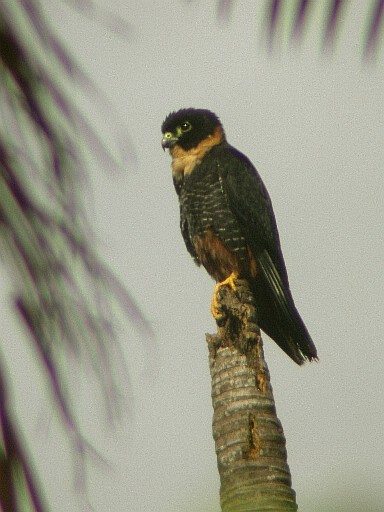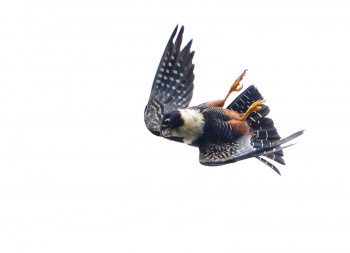(Attempt to disguise some copied text. Taxonomy. References) |
(Flight picture. References updated) |
||
| Line 1: | Line 1: | ||
| − | [[Image:Bat_Falcon.jpg|thumb| | + | [[Image:Bat_Falcon.jpg|thumb|500px|right|Photo by {{user|Erikat|Erikat}}<br />Coronie District, [[Suriname]], June 2003]] |
;[[:Category:Falco|Falco]] rufigularis | ;[[:Category:Falco|Falco]] rufigularis | ||
==Identification== | ==Identification== | ||
| Line 10: | Line 10: | ||
'''Young''' birds are similar but with a buffy throat. | '''Young''' birds are similar but with a buffy throat. | ||
==Distribution== | ==Distribution== | ||
| + | [[Image:Bat falcon.jpg|thumb|350px|right|Hunting<br />Photo by {{user|Luiz|Luiz}}<br />[[Itatiaia National Park|Itatiaia]] highlands, Itamonte, MG, [[Brazil]], March 2011]] | ||
| + | |||
[[Central America|Central]] and [[South America]]: occurs in [[Mexico]] from southern Sonora and Tamaulipas southwards and through Central America to [[Panama]]; in [[South America]] breeds from [[Colombia]], [[Venezuela]], [[Trinidad]] and the [[Guianas]] south to west [[Ecuador]] and northern [[Argentina]]. | [[Central America|Central]] and [[South America]]: occurs in [[Mexico]] from southern Sonora and Tamaulipas southwards and through Central America to [[Panama]]; in [[South America]] breeds from [[Colombia]], [[Venezuela]], [[Trinidad]] and the [[Guianas]] south to west [[Ecuador]] and northern [[Argentina]]. | ||
Resident. | Resident. | ||
==Taxonomy== | ==Taxonomy== | ||
| − | ====Subspecies<sup>[[#References|[1]]]</sup> | + | ====Subspecies==== |
| + | There are 3 subspecies<sup>[[#References|[1]]]</sup>: | ||
*''F. r. petoensis'': | *''F. r. petoensis'': | ||
:*Humid lowlands of northern [[Mexico]] to southern [[Ecuador]] (west of the Andes) | :*Humid lowlands of northern [[Mexico]] to southern [[Ecuador]] (west of the Andes) | ||
| Line 31: | Line 34: | ||
It nests in an unlined tree hole and 2-3 brown eggs are laid. | It nests in an unlined tree hole and 2-3 brown eggs are laid. | ||
==References== | ==References== | ||
| − | #{{Ref- | + | #{{Ref-Clements6thAug11}}#Avibase |
#Wikipedia | #Wikipedia | ||
#BF Member observations | #BF Member observations | ||
Revision as of 22:25, 13 September 2011
- Falco rufigularis
Identification
Female - 30.5 cm, male - 23 cm long male
Adult
- Black back, head and tail
- Creamy-white throat, upper breast and neck sides
- Black lower breast and belly finely barred white
- Orange thighs and lower belly
Young birds are similar but with a buffy throat.
Distribution
Central and South America: occurs in Mexico from southern Sonora and Tamaulipas southwards and through Central America to Panama; in South America breeds from Colombia, Venezuela, Trinidad and the Guianas south to west Ecuador and northern Argentina.
Resident.
Taxonomy
Subspecies
There are 3 subspecies[1]:
- F. r. petoensis:
- F. r. rufigularis:
- Lowlands of northern South America to southern Brazil and northern Argentina; winters in Trinidad
- F. r. ophryophanes:
Subspecies petrophilus is not recognised by all authorities[2]
Habitat
Open woodland, forest edge and plantations, often near water.
Behaviour
Diet
It feeds not only on bats but also on small birds and large insects which it catches on the wing.
Breeding
It nests in an unlined tree hole and 2-3 brown eggs are laid.
References
- Clements, JF. 2011. The Clements Checklist of Birds of the World. 6th ed., with updates to August 2011. Ithaca: Cornell Univ. Press. ISBN 978-0801445019. Spreadsheet available at http://www.birds.cornell.edu/clementschecklist/downloadable-clements-checklist
- Avibase
- Wikipedia
- BF Member observations
Recommended Citation
- BirdForum Opus contributors. (2024) Bat Falcon. In: BirdForum, the forum for wild birds and birding. Retrieved 9 May 2024 from https://www.birdforum.net/opus/Bat_Falcon





